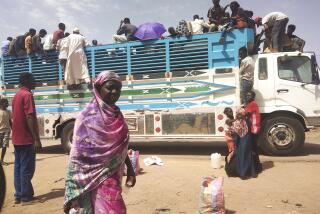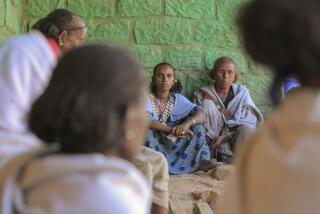Other Somalias Feared as Population Outstrips Food Production : Africa: An in-depth look at world agriculture finds that other trouble spots are possible--next door or even beyond the continent.
- Share via
HOOBISHOOLE, Somalia — Sorghum, the humblest of grains, likes it here on the dry, lonely high plain of south Somalia. But these days, even the hardy sorghum is scarce.
The fields of chocolate-brown earth spreading out for miles around Hoobishoole are more fallow than in full leaf this harvest season. The first grain crop of the “new” Somalia looks thin. The farmers are too weak, too few.
The forecast for the Somali people is for months--even years--of dependence on food aid.
“We farmers lost everything,” said village chairman Aden Mohamed Abdi. “We’ve got to start from zero.”
The Somalia disaster is well known. Civil war conspired with drought to starve a people. An estimated 350,000 died in 1992.
But Somalia is not alone. An in-depth look at world agriculture finds that other Somalias are possible--next door in Ethiopia, elsewhere in Africa, or even beyond this continent in lands now considered “food-secure.”
In its latest early warning bulletin, the U.N. Food and Agriculture Organization lists 20 nations in sub-Saharan Africa facing food emergencies.
In half the cases, it blames civil strife that disrupted food supplies or drove hungry refugees across borders. But the roots of Africa’s food problem lie deeper than in the latest clan wars, and its impact can be found in the continent’s perilous “1% gap.”
Since the 1960s, when it was self-sufficient in food, sub-Saharan Africa’s exploding population has grown an average 3% a year, while its food production has grown only 2% a year.
If harvests continue to trail births at that rate, the World Bank says, within 30 years Africa’s annual “food deficit” will multiply 15 times to 200 million tons of grain--equal to all the corn now grown in North America.
“Only if its population stabilizes can Africa feed itself again,” concludes Peter L. Simkin of the U.N. Development Program, a veteran of African agricultural projects.
The concerns extend beyond Africa.
Crops caught up with population growth in Asia in recent decades, thanks to the “green revolution”--high-yield rice and wheat varieties, well fertilized, well irrigated. But scientists lately find these yields hitting a ceiling, while Asian populations are not.
Although the world, as a whole, produces enough grain to feed everyone, it doesn’t always get to the right places. Either poor nations simply cannot afford food from surplus countries, or food aid is slow, misdirected or stolen.
Agronomists, economists, farmers in the field--all agree that Third World countries should grow their own food staples or, alternatively, develop their economies enough, through agriculture, to buy American corn, Argentine wheat, New Zealand milk.
The challenge is huge, nowhere more so than here on the sun-baked plateau 160 miles northwest of Mogadishu, the Somali capital.
A peace of sorts has returned with the U.S.-led military intervention in Somalia, but the country’s underlying agricultural problems remain: farmers unschooled in modern techniques, poor research, lack of fertilizer, near-impassable roads, lack of irrigation, chronic drought.
The Hoobishoole area--pronounced HOO-bee-SHOO-leh--is Somalia’s breadbasket.
“The soil is good,” said Iowa farmer Kevin Tobin, an agricultural specialist with Catholic Relief Services in nearby Baidoa. “It’s not Iowa, but it’s as good as parts of Missouri, southern Illinois. That tells me the limiting factor is water.”
Insisted Hoobishoole farmer Hussein Aden: “We have water. It’s underground. We need pumps.”
Tobin doubts that the reservoir is big enough. But even if it is, sinking hundreds of wells in Hoobishoole is an expensive dream in an impoverished land.
For now, the farmers are satisfied to have huts to live in.
Under a CARE International resettlement program, Hoobishoole’s 7,600 families are trickling back from refugee camps. They fled in 1991 after government troops, routed in the civil war, rampaged through the area, slaughtering animals, stealing crops and tools, wrecking mud-wall houses.
The dusty, silent village, now a scattering of thatch huts among clumps of bush, gets regular deliveries of sacks of corn from CARE.
“To recover, we need food for two, three, four months,” a somber Sheik Yusuf Sheikhahmed, the local Islamic clergyman, said as he cradled his Koran in his lap.
“We also need seeds. We need medical help. The people lack nutrition. Then we would try to produce.”
Some farmers are already trying, producing a small crop of sorghum.
But the corn-like grain, which they mix into a porridge, has developed a “rust” disease, pointing up still broader problems in Somali agriculture--the shortage of fungicides and other technical support.
Many specialists say agricultural science should focus more on sorghum and millet, traditional crops of semiarid lands, to develop still hardier, higher-yielding varieties and help countries like Somalia.
The Somalis’ immediate needs are more basic, however: a hoe, machete, ax and packet of seeds.
“How many things are lacking here!” Ahmed Mumin Warfa, a leading Somali agronomist, lamented in Mogadishu.
For his relatively uncrowded country, he said, self-sufficiency may be a long-range goal. For Africa, it’s a fantasy.
“There are too many people, too many nomads, too many refugees, from war, from drought. African self-sufficiency is very, very far off.”
More to Read
Sign up for Essential California
The most important California stories and recommendations in your inbox every morning.
You may occasionally receive promotional content from the Los Angeles Times.













